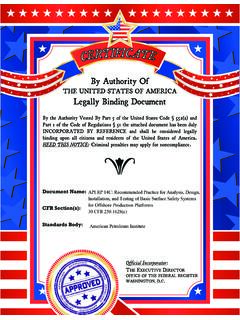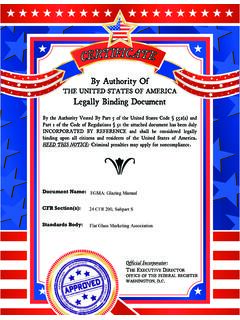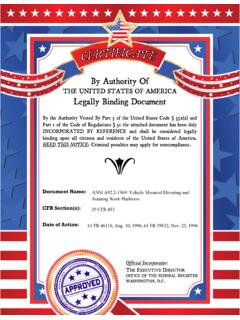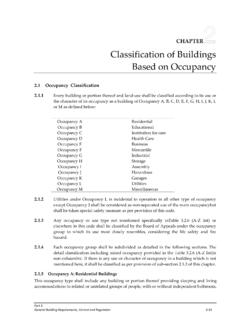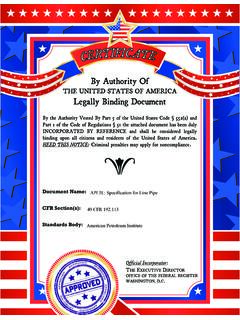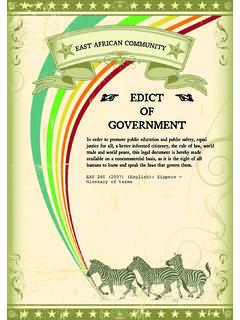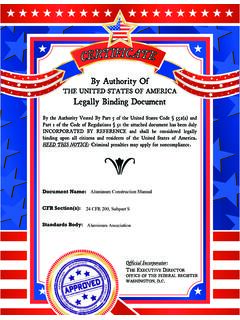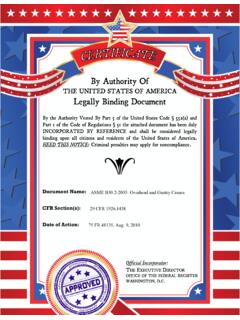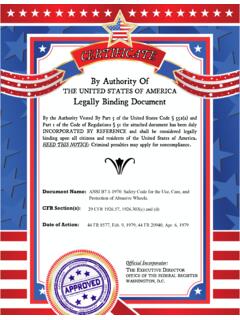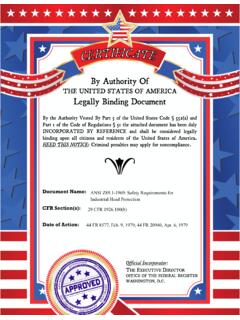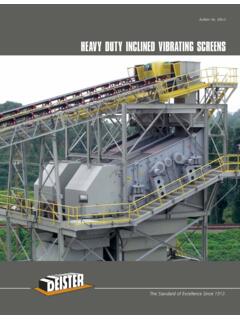Transcription of By Authority Of - Public.Resource.Org
1 By Authority Of THE UNITED STATES OF AMERICA. Legally Binding Document By the Authority Vested By Part 5 of the United States Code 552(a) and Part 1 of the Code of Regulations 51 the attached document has been duly INCORPORATED BY REFERENCE and shall be considered legally binding upon all citizens and residents of the United States of America. HEED THIS NOTICE: Criminal penalties may apply for noncompliance. e Document Name: API 2003: Protection Against Ignitions Arising Out of Static, Lightning, and Stray Currents CFR Section(s): 49 CFR (a). Standards Body: American Petroleum Institute Official Incorporator: THE EXECUTIVE DIRECTOR. OFFICE OF THE FEDERAL REGISTER. WASHINGTON, Protection Against Ignitions Arising Out of Static, Lightning, and Stray Currents API RECOMMENDED PRACTICE 2003. SIXTH EDITION, SEPTEMBER 1998.
2 CSS1 NFO, No part of the of the electronic fiie may be '''"L'' L"~'U'--A::"W. without the written rd:.n'l"u~. \. 20005, American Petroleum Institute Helping You Strategies for Todays Get The Job Environmental Partnership Done Right;M. ~. SJE)t~. Strategies for Today's Environmental Partnership API ENVIRONMENTAL, HEALTH AND SAFETY MISSION. AND GUIDING PRINCIPLES. The members of the American Petroleum Institute are dedicated to continuous efforts to improve the compatibility of our operations with the environment while economically developing energy resources and supplying high quality products and services to consum- ers. We recognize our responsibility to work with the public, the government, and others to develop and to use natural resources in an environmentally sound manner while protecting the health and safety of our employees and the public.
3 To meet these responsibilities, API. members pledge to manage our businesses according to the following principles using sound science to prioritize risks and to implement cost-effective management practices: To recognize and to respond to community concerns about our raw materials, prod- ucts and operations. To operate our plants and facilities, and to handle our raw materials and products in a manner that protects the environment, and the safety and health of our employees and the public. To make safety, health and environmental considerations a priority in our planning, and our development of new products and processes. To advise promptly, appropriate officials, employees, customers and the public of information on significant industry-related safety, health and environmental hazards, and to recommend protective measures.
4 To counsel customers, transporters and others in the safe use, transportation and dis- posal of our raw materials, products and waste materials. To economically develop and produce natural resources and to conserve those resources by using energy efficiently. To extend knowledge by conducting or supporting research on the safety, health and environmental effects of our raw materials, products, processes and waste materials. To commit to reduce overall emissions and waste generation. To work with others to resolve problems created by handling and disposal of hazard- ous substances from our operations. To participate with government and others in creating responsible laws, regulations and standards to safeguard the community, workplace and environment. To promote these principles and practices by sharing experiences and offering assis- tance to others who produce, handle, use, transport or dispose of similar raw materi- als, petroleum products and wastes.
5 Protection Against Ignitions Arising Out of Static, Lightning, and Stray Currents Health and Environmental Affairs Department Safety and Fire Protection Subcommittee API RECOMMENDED PRACTICE 2003. SIXTH EDITION, SEPTEMBER 1998. American Petroleum Institute Helping You Get The Job Done Right~M. SPECIAL NOTES. API publications necessarily address problems of a general nature. With respect to partic- ular circumstances, local, state, and federal laws and regulations should be reviewed. API is not undertaking to meet the duties of employers, manufacturers, or suppliers to warn and properly train and equip their employees, and others exposed, concerning health and safety risks and precautions, nor undertaking their obligations under local, state, or fed- erallaws. Information concerning safety and health risks and proper precautions with respect to par- ticular materials and conditions should be obtained from the employer, the manufacturer or supplier of that material, or the material safety data sheet.
6 Nothing contained in any API publication is to be construed as granting any right, by implication or otherwise, for the manufacture, sale, or use of any method, apparatus, or prod- uct covered by letters patent. Neither should anything contained in the publication be con- strued as insuring anyone against liability for infringement of letters patent. Generally, API standards are reviewed and revised, reaffirmed, or withdrawn at least every five years. Sometimes a one-time extension of up to two years will be added to this review cycle. This pUblication will no longer be in effect five years after its publication date as an operative API standard or, where an extension has been granted, upon republication. Status of the publication can be ascertained from the API Health and Environmental Affairs Depart- ment [telephone (202) 682-8000].
7 A catalog of API publications and materials is published annually and updated quarterly by API, 1220 L Street, , Washington, 20005. This document was produced under API standardization procedures that ensure appropri- ate notification and participation in the developmental process and is designated as an API. standard. Questions concerning the interpretation of the content of this standard or com- ments and questions concerning the procedures under which this standard was developed should be directed in writing to the director of the Health and Environmental Affairs Depart- ment, American Petroleum Institute, 1220 L Street, , Washington, 20005. Requests for permission to reproduce or translate all or any part of the material published herein should also be addressed to the director. API standards are published to facilitate the broad availability of proven, sound engineer- ing and operating practices.
8 These standards are not intended to obviate the need for apply- ing sound engineering judgment regarding when and where these standards should be utilized. The formulation and publication of API standards is not intended in any way to inhibit anyone from using any other practices. Any manufacturer marking equipment or materials in conformance with the marking requirements of an API standard is solely responsible for complying with all the applicable requirements of that standard. API does not represent, warrant, or guarantee that such prod- ucts do in fact conform to the applicable API standard. All rights reserved. No part of this work may be reproduced, stored in a retrieval system, or transmitted by any means, electronic, mechanical, photocopying, recording, or otherwise, without prior written pennission from the publisher.
9 Contact the Publisher, API Publishing Services, 1220 L Street, N. w., Washington, 20005. Copyright 1998 American Petroleum Institute FOREWORD. API publications may be used by anyone desiring to do so. Every effort has been made by the Institute to assure the accuracy and reliability of the data contained in them; however, the Institute makes no representation, warranty, or guarantee in cOlmection with this publication and hereby expressly disclaims any liability or responsibility for loss or damage resulting from its use or for the violation of any federal, state, or municipal regulation with which this publication may conflict. Suggested revisions are invited and should be submitted to the director of Health and Environmental Affairs Department, American Petroleum Institute, 1220 L Street, , Washington, 20005.
10 Iii CONTENTS. Page SCOPE .. 1. 2 REFERENCES.. 1. 3 DEFINITIONS.. 1. 4 STATIC ELECTRICITY HAZARDS .. 2. General .. 2. Tank Truck Loading.. 7. Tank Car Loading.. 14. Marine Operations .. 15. Storage Tanks .. 16. Miscellaneous Electrostatic Hazards.. 20. 5 LIGHTNING.. 26. General.. 26. Direct-Stroke Lightning .. " 27. hldirect Lightning Currents .. 27. Protection of Specific Equipment Against Lightning .. 27. Protection Against Direct-Stroke Lightning .. 29. 6 STRAY CURRENTS .. 29. General.. 29. Sources and Limitations .. 29. Protection of Specific Operations Against Stray Currents .. 30. APPENDIX A FUNDAMENTALS OF STATIC ELECTRICITY .. 33. APPENDIX B MEASUREMENT AND DETECTION OF. STATIC ELECTRICITY .. 41. APPENDIX C DIRECT-STROKE LIGHTNING PROTECTION SYSTEMS .. 43. APPENDIX D BIBLIOGRAPHY .. 45. Figures lA Fixed Spark Promoter.
